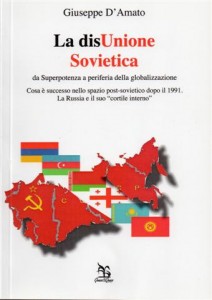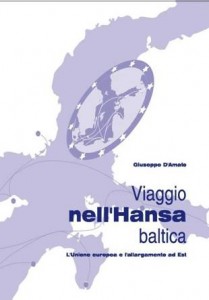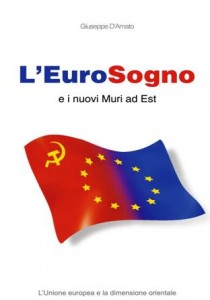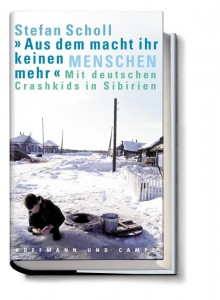Poland and Baltic States
Poland. Smolensk cross at Saint Anne’s.
12 Nov 2010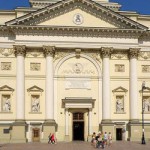 The Smolensk cross has been relocated this week from the Presidential Palace chapel to the nearby St Anne’s church. The move puts an end to a long controversial row. The Catholic Church had accused Poland’s politicians of politicizing the matter.
The Smolensk cross has been relocated this week from the Presidential Palace chapel to the nearby St Anne’s church. The move puts an end to a long controversial row. The Catholic Church had accused Poland’s politicians of politicizing the matter.
The cross was the centerpiece of a conflict between supporters of the Law and Justice party (PiS) on one side and President Komorowski, the government and secular politicians on the other over the place of religious symbols in public places. It was erected in April by the Scouts as a symbol of mourning after the death of President Lech Kaczynski, his wife, and 94 others onboard the plane crashed on landing at Smolensk Severny airport in Russia.
Later in summer, the cross was relocated from outside the Presidential Palace to the palace chapel, in a surprise move which angered protestors who wanted the cross to remain where it was. Following the attempt on 3 August to move it further to St. Anne’s church, just down the road, – when police clashed with protestors – it was decided the cross would be taken on a Pilgrimage leaving two days later to the holy shrine of Jasna Gora in the southern city of Czestochowa, also without success.
Groups of elderly Kaczynski supporters kept guard round the clock for several days to prevent its removal, accusing Komorowski, the Prime Minister Tusk and Civic Platform (PO) of betraying Poland and the Catholic faith. A hard-line group, the so-called “Defenders of the Cross“, opposed any decision unless a permanent memorial would have been installed. Some 77% of Poles surveyed by stats researcher GfK Polonia for Rzeczpospolita daily saw the cross relocation to the presidential chapel as the right decision.
According to a joint statement by the President’s Chancellery, Warsaw diocese, a scout organisation “the Academic Church of St Anne in Warsaw, a place strongly bound to the history of … Poland. This temple is the site of permanent prayers for the tragically perished President Lech Kaczynski, his wife and all victims of the Smolensk catastrophe.”
The two countries have had generally friendly ties since the fall of communism in 1989 and Lithuania regaining independence in 1991 after the collapse of the Soviet Union. Warsaw’s ostentatious disappointment with Vilnius’ decision not to support the Russo-Polish initiative to lift the visa regime for the residents of Kaliningrad region has marked the beginning of a freeze in the bilateral relations.
For months Lithuanian politicians and diplomats have been openly talking about their conviction that a new Polish leadership – composed of members of the liberal party, Civic Platform – would change its foreign policy after the presidential election. And they were right: after July Warsaw paid more attention to Berlin and Moscow than to Vilnius and the latter to Minsk, that is trying to make the Klaipeda oil terminal suitable for importing Venezuelan oil to Belarus.
Even though the new Polish Chief of State Bronislaw Komorowski stems from an old noble Lithuanian family and does not hide his feelings for his historical homeland, he is not someone who is capable of implementing an independent policy, the way that President Lech Kaczynski did, wrote Audrius Baciulis on weekly Veidas.
On Wednesday Foreign Minister Radoslaw Sikorski criticised Lithuania in unusually blunt terms for European Union partners, saying its Baltic neighbour was failing to live up to its commitments either to ethnic Poles or to Polish investors. Some days before meetings among diplomats were postponed until local Poles were allowed to write their names in official documents using Polish letters.
Prime Minister Donald Tusk campaigned in 2007 on expediting privatization, even before the crisis hit, and the revenues from the sales, which were planned to be held from 2008 to 2011, are now helping the country cover a budget deficit that could grow to 8 percent of GDP this year, Tusk admitted this month.
Growth in the country has unfortunately not meant stable public finances, then, as the government has, for the moment, relied on the privatization of more than 800 companies to cover costs. Compared with countries like the Czech Republic and Germany, Poland has not adopted austerity measures, preferring instead to continue feeding growth.
The privatization plan is expected to generate 25 billion złoty (6.4 billion euros) over four years.
Article – The Prague Post – October 2010.
Strade dell’Est europeo insanguinate. Una giornata campale del genere non la si ricordava da tempo. In Polonia in uno scontro frontale ad una ottantina di chilometri da Varsavia 18 persone sono morte. Nella vicina Ucraina è stato addirittura proclamato il lutto nazionale in ricordo di 43 sfortunati viaggiatori, tra cui 3 bambini. I due Paesi slavi, sconfiggendo a Cardiff l’Italia nel 2007, hanno ottenuto l’organizzazione di Euro 2012 in programma tra un anno e mezzo.
La viabilità è uno dei loro più noti “talloni” d’Achille, insieme alla scarsa offerta alberghiera, tanto che l’Uefa ha intenzione di consigliare ai tifosi ospiti stranieri di utilizzare gli aerei per gli spostamenti. La Polonia ha destinato gran parte dei 67 miliardi di euro (pari ogni anno a quasi 3 punti del Pil nazionale), ottenuti dall’Ue dal bilancio comunitario 2007-2013, per l’ammodernamento della vie di comunicazione. I cantieri aperti sono numerosi (a settembre 2010 per 1.327 chilometri), la rete viaria è migliorata un pochino, ma il numero degli incidenti non tende a diminuire anche per l’imprudenza dei guidatori.
Il lavoro da compiere, però, – è necessario sottolinearlo – è immenso: nel 2007 il 3% delle vie di comunicazione polacche rispondeva agli standard continentali. Nel dicembre 2009 il Paese, esteso un po’ meno dell’Italia, poteva contare soltanto su 916 chilometri di autostrade e su 606 di superstrade.
Secondo i primi accertamenti è stata la nebbia una delle cause della tragedia di Nowe Miasto nad Pilica, oltre che all’eccessiva velocità. Un tir si è scontrato frontalmente con un autobus, pieno di passeggeri, su una carreggiata a doppio senso di marcia larga non più di 6 metri. Ma questa è la norma. Non esistono spesso per i camion percorsi alternativi. Così molte di queste strade provinciali, chiamate dai locali “dune” – poiché hanno il manto rovinato (si pattina) ed una segnaletica che lascia parecchio a desiderare – si trasformano in imbuti infernali da cui a volte non se ne esce.
Cosa pensasse di fare, invece, in Ucraina l’autista di un autobus con una cinquantina di passeggeri a bordo non è ancora chiaro. Con una manovra avventata non ha rispettato il segnale rosso di un semaforo ad un passaggio a livello incustodito ed ha invaso le rotaie, mentre transitava una locomotiva. La collisione, a Marganets – regione di Dnipropetrovsk – è stata violentissima tanto che dell’autobus di colore giallo non è rimasto quasi nulla.
Katyn. More documents delivered to Warsaw.
27 Sep 2010The Prosecutor General’s Office has given Polish authorities 20 additional volumes of documents concerning the Soviet execution of Polish officers at Katyn in 1940, the RIA Novosti news agency reports. In May Moscow sent to Poland 67 volumes of the case. The Polish commission insisted, however, that those volumes did not contain any new information concerning the case.
“We are handing over additional 20 files from case #159, which partly fulfills the Polish request,” senior Russian Prosecutor Saak Karapetyan said. The files contain additional lists of Polish servicemen held captive by the Soviet secret police, interrogation and forensic reports, medical records, burial certificates and other data related to the massacre.
In the 1990s, Russia handed over to Poland copies of archive documents from the top-secret File No.1, which placed the blame solely on the Soviet Union. In September 1990, Russian prosecutors also launched a criminal case into the massacre, known as “Case No.159.” The investigation was closed in 2004.
Poland’s Institute of National Remembrance, which has been investigating the case since 2004, has proposed including Russia’s materials into its own investigation.
Sono ormai lontani i tempi in cui la bandiera cecena sventolava sicura sulla piazza del Mercato a Cracovia. La Polonia ha oggi cambiato politica verso la Russia, assecondando sia una naturale esigenza geopolitica dopo decenni di incomprensioni sia richieste sempre più pressanti da parte della sua imprenditoria. L’incidente aereo di Smolensk nello scorso aprile, in cui è scomparsa un’importante fetta dell’establishment di Varsavia, è stato la triste occasione per un avvicinamento, definito da non pochi osservatori come “storico”. Tali scelte della dirigenza liberale Komorowski-Tusk sono, però, avversati dai partiti nazional-conservatori, che gelosamente conservano i tradizionali sentimenti anti-moscoviti.
In questo quadro si sviluppa la vicenda Zavkayev. Il leader dell’ala moderata del separatismo caucasico, a cui è stato garantito dalla Gran Bretagna lo status di profugo, è stato fermato a Varsavia per un ordine d’arresto dell’Interpol su richiesta russa, mentre si apprestava ad intervenire al Congresso mondiale dei ceceni. Un Tribunale l’ha immediatamente messo in libertà e nei prossimi 40 giorni verrà deciso il daffarsi. Mosca sta preparando i documenti per l’estradizione di uno dei suoi maggiori nemici.
Zavkayev è un politico esperto e non ha di certo sottovalutato i rischi di un suo viaggio in continente. In Cecenia da tempo vige la “pax russa” e la ricostruzione avanza a ritmi impressionanti. La repubblica, diretta col pugno di ferro dal clan dei Kadyrov, è uno dei soggetti che ricevono maggiori fondi dal Centro, nonostante nell’aria si respiri un’autonomia di fatto dal Cremlino. Il moderato Zavkayev sta probabilmente tentando di riaccendere i riflettori dei mass media internazionali sul suo Paese.
Il premier Tusk ha dichiarato che Varsavia considererà i “suoi interessi nazionali” nella vicenda. La sensazione è che i suoi avversari interni gli abbiano teso una trappola per silurare le recenti aperture ad Est e Zavkayev, forte del sostegno di ampi settori del Dipartimento di Stato Usa, abbia ricevuto assicurazioni da “amici” fidati in Polonia prima del viaggio d’oltremanica.
President Bronislaw Komorowski has been in Paris and Berlin this week for talks with President Nicholas Sarkozy and Chancellor Angela Merkel. On his first trip abroad as President of Poland since being elected in July, Komorowski has said that reinvigorating the Weimar Triangle – a diplomatic agreement signed by Poland, Germany and France in 1991 – is one of his key objectives.
Regular meetings of leaders and ministers from these countries, which had been held from the 1990s, stalled during the presidency of Komorowski’s late predecessor Lech Kaczynski.
Next year the EU‘s 27 countries will launch negotiations on the shape of the 2014-2021 budget. Many politicians are calling for austerity following the global economic crisis, which has emptied government coffers and increased national debts. “We expect the cohesion fund to be maintained,” Komorowski said, referring to the main EU aid fund. “It is so important to make solidarity real, to make development levels more equal,” he added in a news conference.
Poland is to receive some 67 billion euros in regional aid from the bloc’s long-term budget for 2007-2013. Other former communist countries from central Europe also benefit substantially from EU funds.
Some experts believe that the bloc’s budget will remain at least at the current level of around 1 percent of the Union’s economic output. The budget talks will also concern the future of the EU’s farm subsidies, which account for more than 40 percent of the expenditure. A special Parliament committee met in July.
In Berlin President Komorowski visited the Sachsenhausen concentration camp memorial near the capital, together with German President Christian Wulff, to pay respects to a war hero. He then explained that this is “a way to demonstrate our shared view of our terrible past.”
Warsaw. New Monument to Napoleon.
27 Aug 2010Napoleon was widely appreciated in Poland. Erecting monuments to the Emperor was not accepted by the three occupants of the Slavic country. After restoring independence in 1918 the hundredth anniversary of his death was celebrated in Poland nearly as it was in France.
Warsaw City Council has just given the go-ahead for the construction of a monument at the site of an old statue on Plac Powstańców Warszawy, which used to be known as Napoleon Square before World War Two
Article – Radio Polska; Napoleon’s Monuments in Poland – History.
Newsweek magazine compiled a list of the 100 best countries in the world to live in according to 5 categories: health, economic dynamism, education, political environment and quality of life. Top 3 include Finland, Switzerland and Sweden.
Estonia ranks 32nd, Lithuania 34th and Latvia 36th. Ukraine takes the 49th place having outrun Russia 51st and Belarus 56th.
Burkina Faso, Nigeria and Cameroon are recognized to be the world worst countries.
At the end of July, Poland’s cabinet adopted a preliminary list of priorities for Poland’s EU presidency, which included the EU budget for 2014-2020. The negotiations of the EU budget for 2014- 2021 will be a crucial factor, determining the success of Poland’s presidency.
Article – August 19th, 2010.
Welcome
We are a group of long experienced European journalists and intellectuals interested in international politics and culture. We would like to exchange our opinion on new Europe and Russia.
Categories
- Breaking News (11)
- CIS (129)
- Climate (2)
- Energy&Economy (115)
- EU Eastern Dimension (85)
- Euro 2012 – Sochi 2014 – World Cup 2018, Sport (43)
- Euro-Integration (135)
- History Culture (198)
- International Policy (261)
- Military (74)
- Interviews (18)
- Italy – Italia – Suisse (47)
- Odd Enough (10)
- Poland and Baltic States (126)
- Religion (31)
- Russia (421)
- Survey (4)
- Turning points (4)
- Ukraine (176)
- Российские страницы (113)
Archives
- November 2020
- October 2020
- September 2020
- August 2020
- July 2020
- May 2020
- April 2020
- March 2020
- January 2020
- December 2019
- November 2019
- October 2019
- September 2019
- August 2019
- July 2019
- June 2019
- May 2019
- April 2019
- March 2019
- February 2019
- December 2018
- November 2018
- October 2018
- September 2018
- August 2018
- July 2018
- June 2018
- May 2018
- April 2018
- March 2018
- February 2018
- January 2018
- December 2017
- November 2017
- October 2017
- September 2017
- August 2017
- July 2017
- May 2017
- March 2017
- January 2017
- December 2016
- November 2016
- October 2016
- September 2016
- July 2016
- June 2016
- May 2016
- April 2016
- February 2016
- January 2016
- November 2015
- October 2015
- September 2015
- June 2015
- April 2015
- March 2015
- February 2015
- January 2015
- December 2014
- November 2014
- October 2014
- September 2014
- August 2014
- July 2014
- June 2014
- May 2014
- April 2014
- March 2014
- February 2014
- January 2014
- December 2013
- November 2013
- October 2013
- September 2013
- August 2013
- July 2013
- June 2013
- May 2013
- April 2013
- March 2013
- February 2013
- January 2013
- December 2012
- November 2012
- October 2012
- September 2012
- August 2012
- July 2012
- June 2012
- May 2012
- April 2012
- March 2012
- February 2012
- January 2012
- December 2011
- November 2011
- October 2011
- September 2011
- August 2011
- July 2011
- June 2011
- May 2011
- April 2011
- March 2011
- February 2011
- January 2011
- December 2010
- November 2010
- October 2010
- September 2010
- August 2010
- July 2010
- June 2010
- May 2010
- April 2010
- March 2010
- February 2010
- January 2010
- December 2009
- November 2009
- October 2009
- September 2009
- August 2009
Our books
